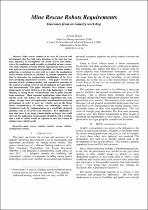JavaScript is disabled for your browser. Some features of this site may not work without it.
- ResearchSpace
- →
- Research Publications/Outputs
- →
- Conference Publications
- →
- View Item
| dc.contributor.author |
Green, J

|
|
| dc.date.accessioned | 2014-02-13T08:58:56Z | |
| dc.date.available | 2014-02-13T08:58:56Z | |
| dc.date.issued | 2013-10 | |
| dc.identifier.citation | Green, J. 2013. Mine rescue robots requirements: Outcomes from an industry workshop. In: IEEE 6th Robotics and Mechatronics (RobMech) conference 2013, Durban, 30-31 October 2013 | en_US |
| dc.identifier.uri | http://ieeexplore.ieee.org/stamp/stamp.jsp?tp=&arnumber=6685501 | |
| dc.identifier.uri | http://hdl.handle.net/10204/7208 | |
| dc.description | IEEE 6th Robotics and Mechatronics (RobMech) conference 2013, Durban, 30-31 October 2013.Post print attached. | en_US |
| dc.description.abstract | Mine rescue robotics is an area of research and development that has had some attention in the past, but has been bypassed in development by urban search and rescue, where the conditions could arguably be classified as less extreme. The safety situation in South African underground mines is such that work in rescue robotics can be justified. At a recent industry gathering, a workshop was convened to explore the applications where robotics could be of assistance in current operations, and then to determine the requirements specifications of the three most promising deployment scenarios. This paper records the outcome of that workshop session, and expands the outcomes in the context of existing research and development in South Africa and internationally. The paper identifies three definite robot deployments in South Africa as a) box hole deployment (vertical tunnels), b) flying drone reconnaissance and c) proto (rescue) team assistance. These represent applications where there is a market need, and defines the required capabilities for such robots. In some cases, the requirements would need research and development in order to meet the criteria, such as the flying drone reconnaissance. In others, the technology could be considered ready for implementation in a specifically designed machine, such as for proto team assistance. It is significant to note that there is no single robotic platform design that could meet all the application requirements identified, and it is likely that a suite of robots would be required to meet the variety of mining rescue robotic needs. | en_US |
| dc.language.iso | en | en_US |
| dc.publisher | IEEE Xplore | en_US |
| dc.relation.ispartofseries | Workflow;10299 | |
| dc.subject | Mine rescue | en_US |
| dc.subject | Mining robotics | en_US |
| dc.subject | Rescue robotics | en_US |
| dc.subject | Underground robotics | en_US |
| dc.title | Mine rescue robots requirements: Outcomes from an industry workshop | en_US |
| dc.type | Conference Presentation | en_US |
| dc.identifier.apacitation | Green, J. (2013). Mine rescue robots requirements: Outcomes from an industry workshop. IEEE Xplore. http://hdl.handle.net/10204/7208 | en_ZA |
| dc.identifier.chicagocitation | Green, J. "Mine rescue robots requirements: Outcomes from an industry workshop." (2013): http://hdl.handle.net/10204/7208 | en_ZA |
| dc.identifier.vancouvercitation | Green J, Mine rescue robots requirements: Outcomes from an industry workshop; IEEE Xplore; 2013. http://hdl.handle.net/10204/7208 . | en_ZA |
| dc.identifier.ris | TY - Conference Presentation AU - Green, J AB - Mine rescue robotics is an area of research and development that has had some attention in the past, but has been bypassed in development by urban search and rescue, where the conditions could arguably be classified as less extreme. The safety situation in South African underground mines is such that work in rescue robotics can be justified. At a recent industry gathering, a workshop was convened to explore the applications where robotics could be of assistance in current operations, and then to determine the requirements specifications of the three most promising deployment scenarios. This paper records the outcome of that workshop session, and expands the outcomes in the context of existing research and development in South Africa and internationally. The paper identifies three definite robot deployments in South Africa as a) box hole deployment (vertical tunnels), b) flying drone reconnaissance and c) proto (rescue) team assistance. These represent applications where there is a market need, and defines the required capabilities for such robots. In some cases, the requirements would need research and development in order to meet the criteria, such as the flying drone reconnaissance. In others, the technology could be considered ready for implementation in a specifically designed machine, such as for proto team assistance. It is significant to note that there is no single robotic platform design that could meet all the application requirements identified, and it is likely that a suite of robots would be required to meet the variety of mining rescue robotic needs. DA - 2013-10 DB - ResearchSpace DP - CSIR KW - Mine rescue KW - Mining robotics KW - Rescue robotics KW - Underground robotics LK - https://researchspace.csir.co.za PY - 2013 T1 - Mine rescue robots requirements: Outcomes from an industry workshop TI - Mine rescue robots requirements: Outcomes from an industry workshop UR - http://hdl.handle.net/10204/7208 ER - | en_ZA |






